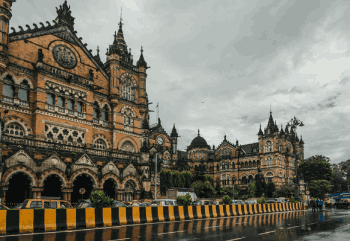The Mumbai Monsoon 2025 has once again exposed the vulnerabilities of India’s financial capital, as heavy rainfall, waterlogging, and urban flooding crippled the city in August. With the India Meteorological Department (IMD) issuing multiple red alerts, the extreme weather not only disrupted daily life but also highlighted deeper systemic issues—climate change, inadequate infrastructure, and rapid urbanization. This article provides a comprehensive, data-driven analysis of Mumbai’s recurring flood crisis, exploring rainfall patterns, scientific causes, infrastructure deficits, and evidence-based remediation strategies.
Mumbai Rainfall Data: 2025 in Numbers
The 2025 monsoon season is proving exceptional both in intensity and timing:
- May 2025: Colaba Observatory recorded 456.5 mm, making it the wettest May since records began in 1901 (previous: 280 mm in 1918).
- August 18, 2025: A torrential downpour of 177 mm in just 8 hours triggered IMD’s red alert warning.
- Daily Extremes: On May 25–26, 135.4 mm of rain fell against a normal of just 0.2 mm, representing a 67,600% excess.
- Monsoon Arrival: Advanced to May 26, 16 days earlier than the historical average of June 11.
Comparative analysis shows that Mumbai already received 50% of its average August rainfall in a single day, overwhelming drainage systems designed for far less capacity. Areas like Vikhroli (135 mm), Chembur (124 mm), Juhu (123 mm), and Santacruz experienced rainfall levels well beyond the city’s infrastructure threshold.
Scientific Causes Behind Mumbai Floods
Mumbai’s urban flood risk is shaped by a mix of climate dynamics and human interventions:
- Global Warming: For every 1°C rise in temperature, the atmosphere holds 7% more moisture, fueling extreme downpours. May 2025 alone recorded 7 western disturbances, nearly double the historical average.
- Urban Heat Island Effect: With concrete covering 70% of land, Mumbai is 2–4°C warmer than surrounding areas, intensifying convection and localized cloudbursts.
- Geographical Constraints:
- 80% of Mumbai lies below 10 meters above sea level.
- 180 of 186 storm drains are impacted by high tides.
- Reclaimed land and shrinking natural buffers, such as mangroves (40% loss since the 1990s) and wetlands, amplify flood vulnerability.
Infrastructure Deficit: Why Mumbai Floods Every Year
Despite massive spending, Mumbai’s drainage and flood defense systems remain structurally inadequate:
- Outdated Design: Built in colonial times to handle 25 mm/hour rainfall, far below today’s 100+ mm/hour extremes.
- Population Growth: A drainage network built for 3 million now serves over 20 million.
- Technical Failures: Flat gradients, clogged drains, and mixed sewage-stormwater systems reduce efficiency.
Flood hotspots include Sion Circle, Hindmata Market, Andheri Subway, Milan Subway, and Mankhurd Tunnel, many recording water levels of 3–15 feet during peak downpours.
Current Mitigation Measures
The BMC (Brihanmumbai Municipal Corporation) has launched multiple flood management projects, with mixed success:
- Waterlogging hotspots reduced from 440 to 84.
- 16.67 crore liters holding pond capacity created in areas like Hindmata Market and Milan Subway.
- 16 pumping stations operational, reducing flooding at key choke points.
- ₹3,500+ crores invested since 2020, though projects like BRIMSTOWAD remain only 50% complete.
While these efforts show measurable results, they are still insufficient against the scale of extreme rainfall events.
Future Risks
- Sea Level Rise: Projected 10–25 cm by 2050, worsening coastal drainage.
- Extreme Rainfall Events: Frequency of 100+ mm/day downpours expected to rise by 40%.
- Economic Impact: McKinsey estimates potential damages of $920 billion by mid-century if resilience measures lag.
- Population Pressure: By 2035, Mumbai’s population may cross 25 million, straining already weak infrastructure.
Evidence-Based Solutions
A three-phase flood resilience strategy is essential:
Immediate (1–3 years)
- Expand rainfall monitoring stations from 139 to 300+.
- Implement AI-powered predictive analytics for 6-hour advance flood warnings.
- Upgrade 50 major drains and add 25 pumping stations.
Medium-Term (3–7 years)
- Restore 2,000 hectares of mangroves and conserve wetlands.
- Enforce flood zoning and stricter building codes.
- Create green corridors and permeable surfaces to absorb runoff.
Long-Term (7–15 years)
- Develop underground water reservoirs with 50 crore liter capacity.
- Construct tidal barriers to prevent backflow.
- Build a sponge city framework, mandating 30% green coverage in new projects.
Key Success Indicators by 2030
- Floodwater recedes within 6 hours after 100mm rainfall events.
- Economic losses reduced from ₹2,000 crores to under ₹500 crores annually.
- Public transport disruption capped at <2 hours.
- Zero flood-related deaths achieved through preparedness.
Mumbai as a Case Study for Coastal Megacities
The Mumbai Heavy Rainfall crisis of 2025 is not just a local issue—it’s a global climate adaptation challenge. Urban megacities like Bangkok, Jakarta, and Manila face similar risks from sea level rise, poor drainage, and unplanned growth. Mumbai’s experiences, backed by data-driven flood analysis and climate adaptation strategies, offer valuable lessons for building future-ready cities.
Mumbai’s resilience depends on urgent investment, integrated planning, and community participation. The time to act is now.







